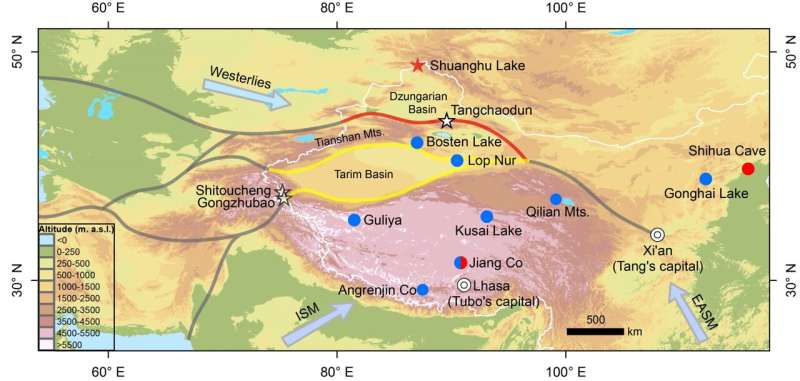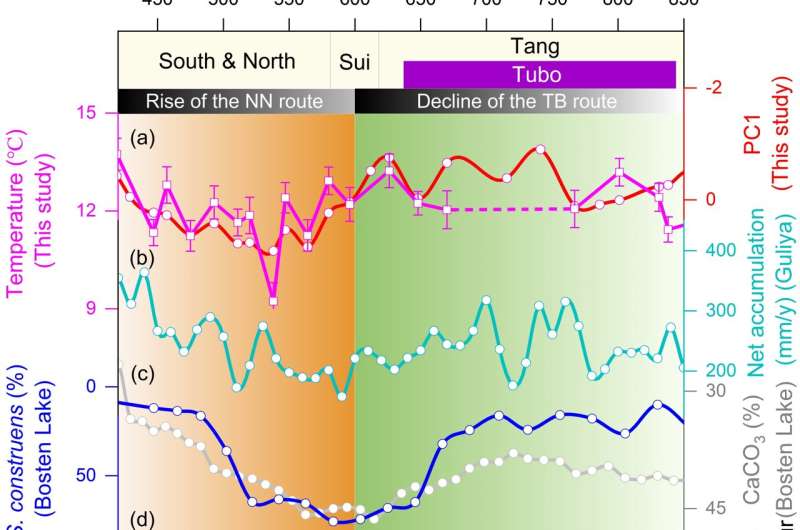This article has been reviewed according to Science X's editorial process and policies. Editors have highlighted the following attributes while ensuring the content's credibility:
fact-checked
trusted source
proofread
Study: Climate change drove the route shift of the ancient Silk Road in two distinct ways

Climate change has convincingly been linked to the evolution of human civilization on different temporal scales. In a recent study published in the journal Science Bulletin, researchers note that the role of climate change in influencing spatial changes in ancient civilizations is rarely investigated. They found that the northward shift of the ancient Silk Road (SR) route in arid NW China provides a rare opportunity to carry out such studies.
After the dispatch of Zhang Qian to the Western Regions (a historical name referring to arid NW China) in the 2nd century BCE by Emperor Wu of the Chinese Han Dynasty, the Tarim Basin route of the SR was gradually established. From the South-North Dynasties (420–589 CE) to the Tang Dynasty (618–907 CE), the New Northern route along the northern slopes of the Tianshan Mountains began to rise, and gradually replaced the Tarim Basin route as the major route of the SR in this region.
The rise of the New Northern route promoted the development of the Turco-Sogdian Milieux, connected the Chinese dynasties and nomadic regimes in Central and West Asia (e.g., the Khazar Empire), and facilitated communications and commerce from the Pacific to the Atlantic. However, the reasons for the northward shift of the SR route remain unclear, and whether climate change played a key role in this shift is a scientific question worthy of discussion.
Water resources are the most important environmental factor restricting human activities in the study area, and it is strongly affected by temperature and precipitation changes: temperature can affect runoff by regulating meltwater, and precipitation is a direct provider of water resources. Previous paleoclimate studies have basically reached a consensus on the variation of precipitation/humidity in this region, but there is still a great dispute on the history of temperature change.

In this study, the researchers obtained a new high-quality chironomid-based temperature record from Shuanghu Lake in arid NW China. By integrating the available hydroclimatic data, the newly measured ages of the ancient city sites along the SR, and the newly obtained war frequency records through literature collation, they investigated the possible influence of climate change on the shift of the SR routes from the South-North Dynasties to the Tang Dynasty.
The results show that low temperature during ~420-600 AD in the study area reduced meltwater. Meanwhile, the precipitation greatly diminished. Decreased meltwater and precipitation together led to water shortage and triggered the shift of the SR route from the Tarim Basin to the northern slopes of the Tianshan Mountains where water resources were more abundant and stable.
It reflects the direct impact of climate change on the shift of the SR routes. Interestingly, during the subsequent period of ~600 to 850 AD, the warm and wet climate did not prevent this shift, because of the geopolitical conflicts between the Tubo Kingdom and the Tang Dynasty in the Tarim Basin—the rise and expansion of the Tubo Kingdom were closely related to the relatively favorable climate on the Tibetan Plateau at that time. It thus reflects the indirect impact of climate change on the SR shift.
This study reveals two distinct ways in which climate change drove the spatial evolution of human civilization: direct impact (deterioration of living environment) and indirect impact (geopolitical conflicts), which has potential significance for understanding the migration of ancient populations between Eurasia and the challenges that mankind may face in the context of current global warming.
More information: Haipeng Wang et al, Climate change drove the route shift of the ancient Silk Road in two distinct ways, Science Bulletin (2024). DOI: 10.1016/j.scib.2024.02.025
Provided by Science China Press




















